Facebook offers a wide range of tools to help financial advisors create the best ads to attract potential clients. But what makes an ad on Facebook effective? And how can you start leveraging Facebook’s platform to your benefit? Using best practices and piggybacking on the success of some other advisor Facebook ads can help. This guide will show you how to create the best ads on Facebook to generate new leads for your advisory business.
Should Financial Advisors Use Facebook Ads?
Several factors make Facebook an excellent platform for advisors. First, Facebook is in the top 10 free downloads on the app store. With Facebook messenger and Instagram above it, this means Facebook takes 3/10 slots in the top 10, meaning Facebook can provide you with a unique opportunity to attract and connect with an untapped, larger audience.

Also, a large amount of Facebook users make above-average wages ($75,000 or more), according to a study of social media usage from the Pew Research Center. So, if your business operates on minimums this data can be super helpful to determine if Facebook is the right platform to allocate your time and budget towards.
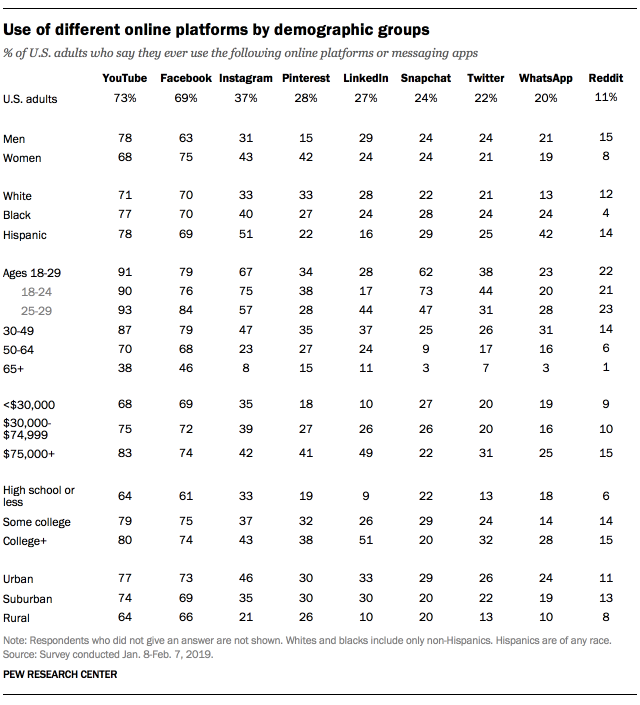
Best of all, Facebook offers very specific tools for targeting your audience. From defining location and age to advertising on specific devices, Facebook offers the opportunity for financial advisors to create ads tailored to the unique needs of potential clients. Some example targeting options include:
- Location. Where does your audience live?
- Demographics. Who is your target audience? What do they do for a living? How old are they? Etc.
- Interests. What does your audience do in their free time?
- Behavior. When do they usually click on an ad? How likely is it they will purchase your product?
- Connections. Leverage your Facebook groups, or find new members
These are only a few examples of the audience targeting that Facebook offers. By understanding your target audience, you can create ads that reach them directly. In turn, generating more leads and costing you less overall. A win-win! (Looking to stand out even more on Facebook? Check out our post on boosting your online presence on Facebook).
How Financial Advisors Can Create Effective Facebook Ads
An effective Facebook ad nails four categories – copy, branding, video and images. And making sure these four areas of your ad are high quality will drastically improve your ad conversion rate and overall performance.
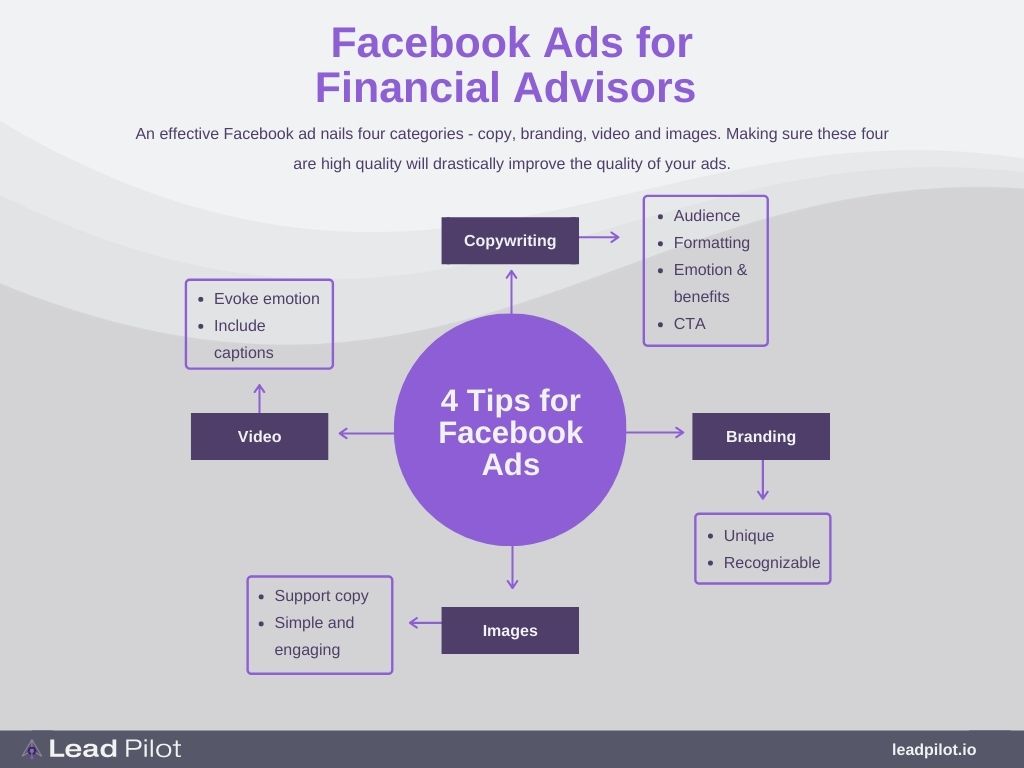
Copywriting
Imagine you log into Facebook and run into two ads that link to the same article. You’re interested in the subject, but one ad has short, descriptive text and a video. The other ad is a wall of text, and that’s it. Which one would you prefer to read and click into? By following these five simple ad copywriting tips you can ensure your ads will be interesting to your target audience and generate more engagement.
1. Use efficient formatting:
Write to be skimmable, avoiding overly complicated terms, and opting for conversational language. This includes adding any relevant keywords that may help your post stand out. Ask yourself the following:
- Would you stop on this post?
- Is this post easy to understand outside of the financial services industry? (i.e. no financial jargon)
- Does this ad use applicable keywords related to your niche?
2. Talk to your audience:
Who do you want to click on your ad? Writing in an appropriate tone and using effective keywords can narrow the focus of your ad. This will help Facebook’s targeting get you in front of the right audience. Ask yourself the following when writing:
- Who is this person? What are their biggest concerns?
- What type of tone would appeal to this person? Fun? Educational?
- Would your audience respond to emojis? Would they be inappropriate?
- What sort of language (keywords) does this audience use?
Using our first two tips, HCP Wealth Management is a good example of excellent copywriting for Facebook ads. Their copy isn’t too wordy or clumped, and it targets a specific audience through sports.
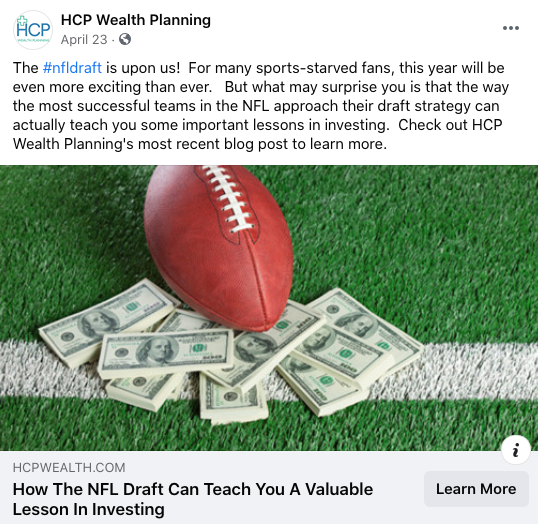
3. Include a value proposition
Every great ad demonstrates value, but there are a few nuances to consider. For example, keep your focus on the audience when writing your copy. Instead of saying “We provide quick and easy services,” say “Her problem was solved quickly and easily.” Both examples provide the same information, but one focuses on the audience (and their pain points). Ask yourself these questions when determining your value proposition:
- What problem are you solving and how do you solve it differently than your competitors?
- Is this a benefit? Or a feature? (“Easy” and “fast” are benefits, different retirement options are a feature. Understanding the difference can help improve your advertising efforts)
- What sort of language are you using? Are you focused on your audience and their pain points?
Bradley Clark of Clark Asset Management gets right to the value of his message by presenting readers with a free guide, enticing them to click the ad link.

4. Evoke emotion:
Emotion is a driving force. Demonstrating the benefits of your service will show how you can help, but emotion creates the motivation to seek that help. Find ways to connect with your audience. Sympathize, or show you’re excited to help them succeed. Whatever it is, remember to be authentic. Insincerity will only hurt your ad.
- What do you want your audience to feel when they see your ad?
- How does this emotion connect to your overall mission?
- Does this emotion drive action?
5. Always include a call-to-action:
If benefits and emotions catch your audience’s attention and motivate them, your call-to-action (or CTA) is the final push to turn an audience member into a lead. Your CTA should always ask your viewer to do something, like press a button to “learn more” to click a link to “book now.” Ask yourself the following when deciding on a call-to-action:
- How does the rest of your ad support my CTA?
- What is the action you want your audience to take?
Ellevest is more than a regular advisory firm, but their ad below cuts right to the core of their message, making it a perfect example of an effective call-to-action.
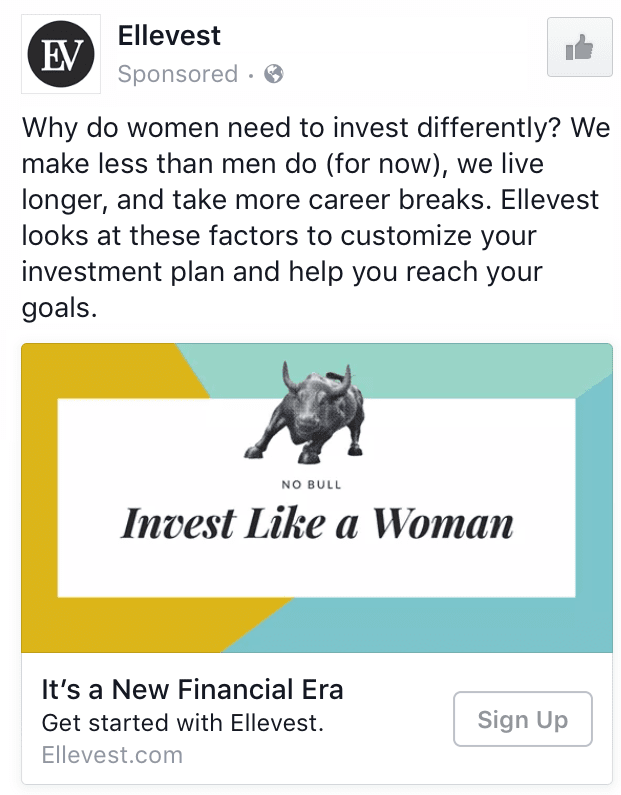
Branding
Think of a few of your favorite companies. A saying, catchphrase, colors or maybe even a face comes to mind. You probably also know their mission statement. Branding helps these companies stand out and combine elements to create a public image. With the popularity and effectiveness of Facebook ads, branding can help advisors become memorable to potential clients.
1. Make it recognizable:
Include your brand colors or any themes associated with your brand. This will enable your audience to recognize you and create cohesion between your ad and your landing pages. Better yet, if an audience member doesn’t click the first ad they see, they may be more inclined to click an ad they recognize later.
- Are there any specific colors you utilize on your landing pages?
- What sort of theme do you want to portray between ads? Landscapes? Abstract? People?
By using various shades of orange and repeating the image of a 3, Trilogy Funding’s ad is an excellent example of recognizable branding.
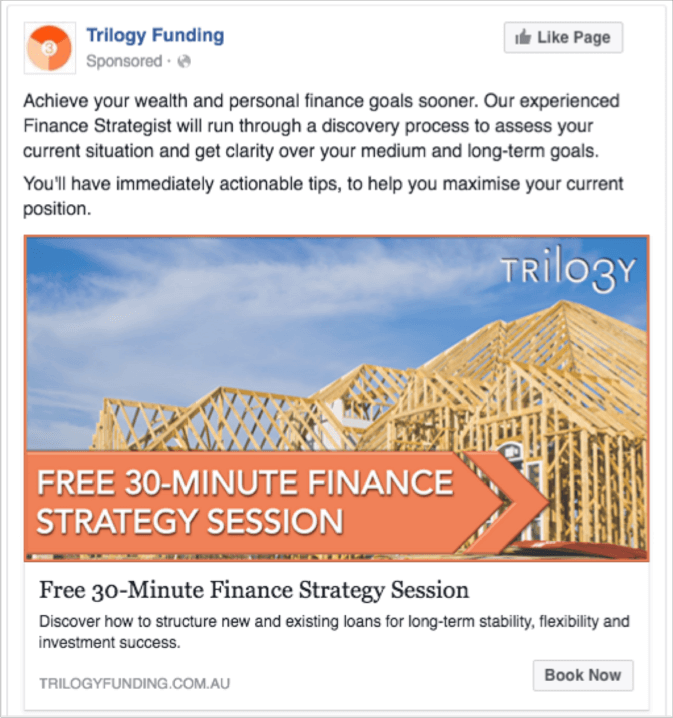
2. Make it unique:
Sure, a sunny sky and palm trees on the beach sound nice, but that’s not everyone’s retirement. Considering your audience in every part of your ad is necessary, but especially when trying to stand out.
- What are the interests of your audience?
- How does your ad stand up to the competition?
This example from Truman Wealth Advisors does a good job of using different branding methods in their Facebook ad. Their ad is more personal (everyone is working from home right now!) by using a Zoom call recording. When compared to the competition, the focus on women in both the image and copy makes the ad more unique and likely to grab someone’s attention as they’re scrolling through their Facebook feed.

Images:
Images receive 230% more engagement, according to BuzzSumo’s study on images in marketing. Including an image (and video in this case) can serve to support the rest of your ad. What can you do to make sure your images are serving your advertising and not distracting?
1. Support the copy:
Imagine a Facebook ad about investment planning. What sorts of images do you think would support this ad? Maybe a tree or money comes to mind. These are cliche examples, but that’s because they’re immediately related to your copy. Make sure your image supports your copy but doesn’t distract the viewer. It should draw attention to and support the rest of your ad.
- What is the main focus of your ad and how is it related to your audience?
- Does your image backup this perspective? Try asking others, a second set of eyes can help.
- Does your image make your viewer want to learn more? Will it direct them to your call-to-action?
2. Keep it simple but engaging:
Infographics, photos and abstract art can all be used to draw attention to your ad. If you’re using royalty-free images, make sure they’re unique. You don’t want to use the same photo as everyone else. Keeping it simple and engaging is a difficult balance, so ask yourself the following to help:
- Are you using a free image? Spice it up a bit by using a marketing tool like Canva, or simply resizing and clipping.
- Does your image distract from the rest of the ad, or support it?
- Would you stop scrolling through Facebook if you saw this image?
Lead Pilot user, Lucid Wealth Planning, does a great job of this by getting right to the core of the problem, money management. By using a piece of content from the Lead Pilot library they were able to use the copy provided as the title, while further supporting the copy with the chosen image.

Video:
According to Hubspot’s survey of content trends, video is quickly becoming the most in-demand form of media. Facebook ads follow this trend. But, if you can’t create video content, consider making shorter .gifs for a similar effect.
1. Support your copy and evoke emotion (quickly):
Like images, video allows you to catch your viewer’s attention. But because of the success and growth of video, your message needs to be quick! According to Facebook, you only have 3 seconds to capture your audience’s attention. This is why emotion is so important – your viewer needs to quickly connect with the video.
- What is the main message or conflict of your video? Make sure to present it within the first 3 seconds.
- What emotion are you trying to evoke?
2. Include captions in your videos:
No one likes to scroll through Facebook on their phone, only to have an ad appear, blasting at full volume! In fact, 85% of Facebook users prefer videos with captions, according to Digiday. Including captions can make your ad less intrusive, and provide you with an opportunity to incorporate your copy in other ways. Beyond including captions of your video transcript, consider including the following:
- How will you differentiate transcript text from other text on the screen?
- Do you repeat your call-to-action in the video?
Images and short clips of HCP Wealth Planning’s chosen audience (medical professionals) fly by in this ad. By including captions that support their copy and evoke emotion, they improve the likelihood of attracting a click and new lead.
(Interested in learning more about video marketing for your business? Check out our webinar on how to attract and convert video viewers into leads).
How Financial Advisors Can Use Lead Pilot to Create Facebook Ads (With Examples)
Here’s a Facebook ad example from Lead Pilot user, Lifewater Wealth Management. We love how they decided to use an infographic from our content library, and customized the post content with emojis.
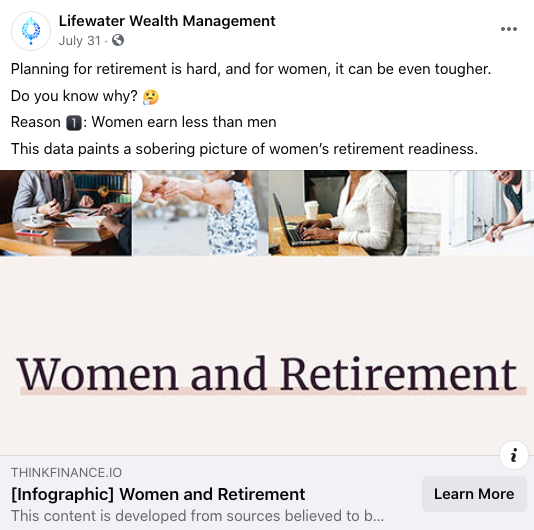
Results:
With an ad budget of $10, Lifewater was able to generate 15 clicks and reach 1,626 individuals in only 5 days using this ad.
One of Lifewater’s other ads targeted a larger audience, with similar results.
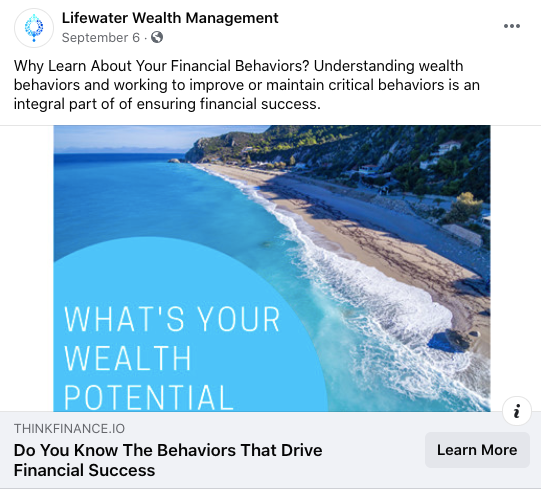
Results:
With a slightly higher ad budget ($25) Lifewater received 18 clicks and reached 3,979 individuals within 5 days.
As you can see, creating content for effective ads can be time-consuming. Why not let us help? Lead Pilot contains a variety of content to help you generate leads – from editorials to infographics, video and interactive content. We offer curated and customizable campaigns to schedule your posts ahead of time, so you can adjust content to fit your needs (remember that branding tip)? And best of all, our platform contains an integrated lead capture form on all of your landing pages, allowing you to track leads and drive conversions. Lead Pilot even contains analytics for tacking potential clients and works seamlessly with Facebook Pixel. Learn how we can help by checking out more details on Lead Pilot.
Related: 6 Ways Advisors Can Use Video in Email Marketing to Supercharge Engagement


